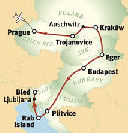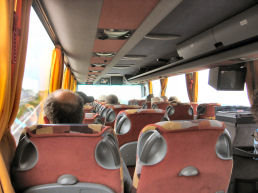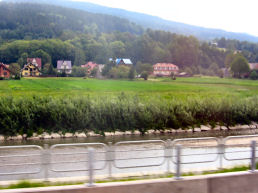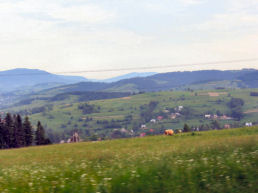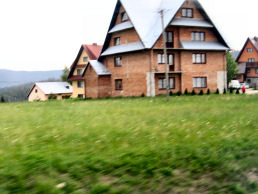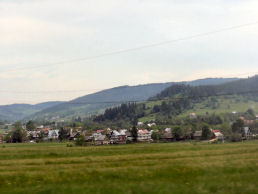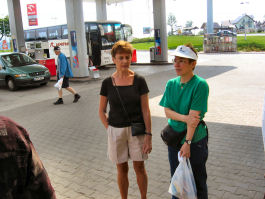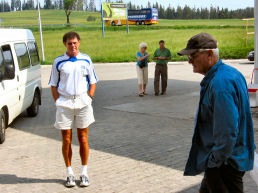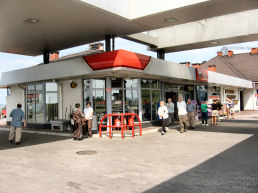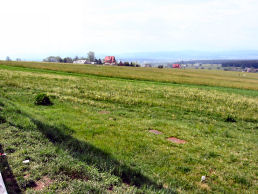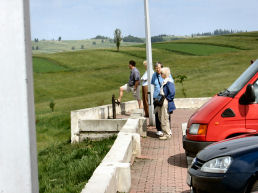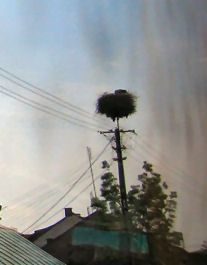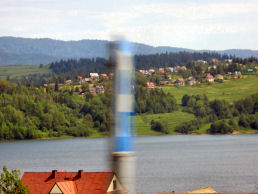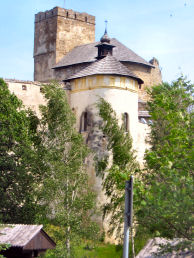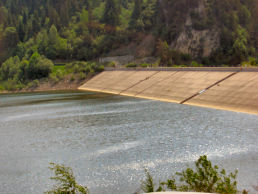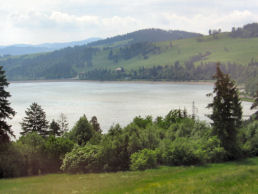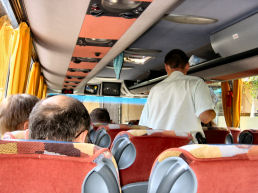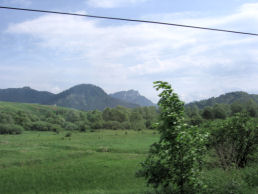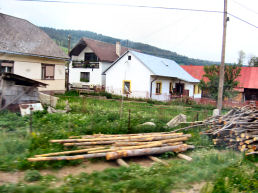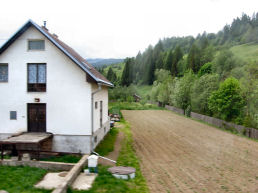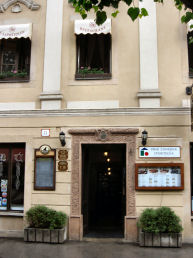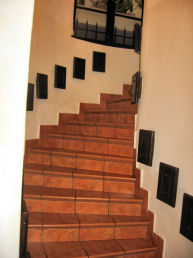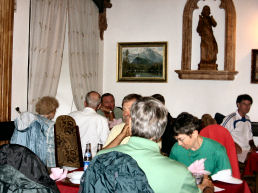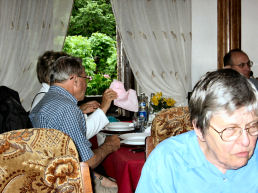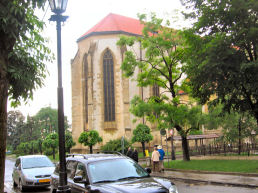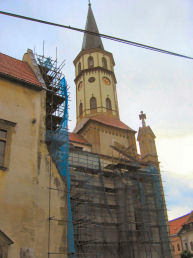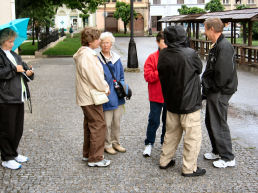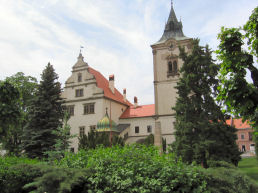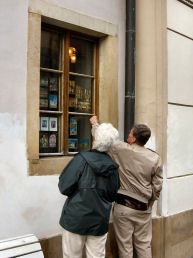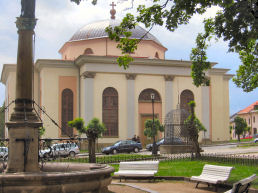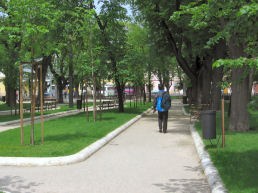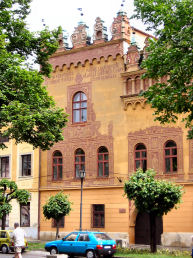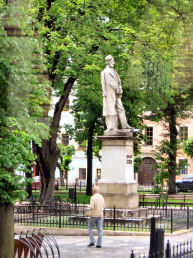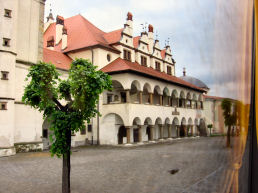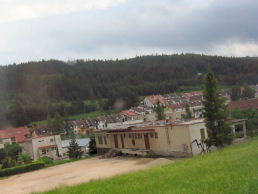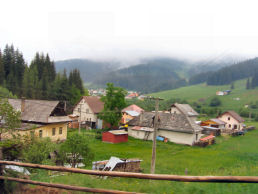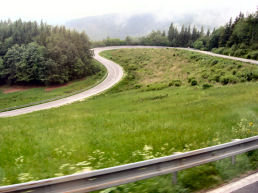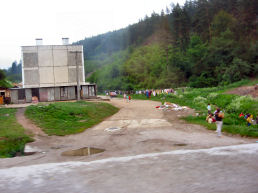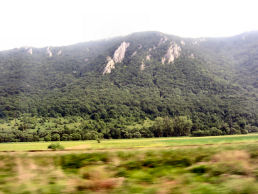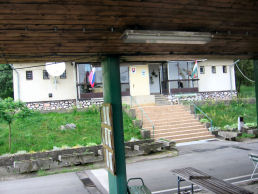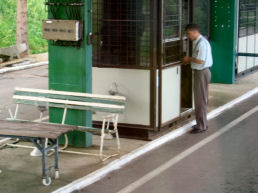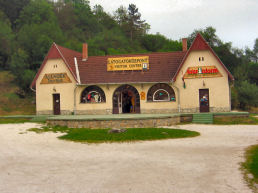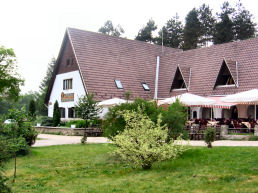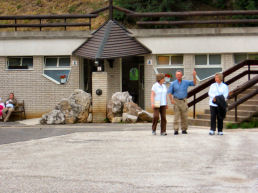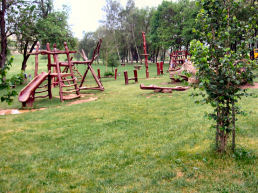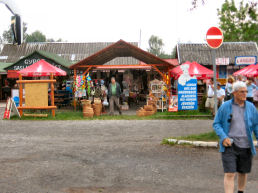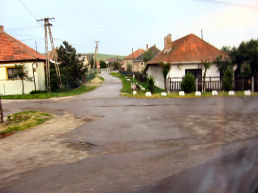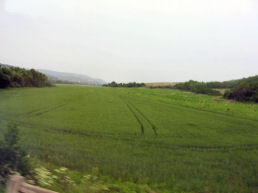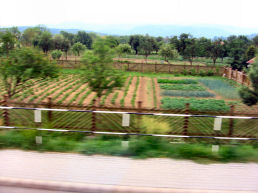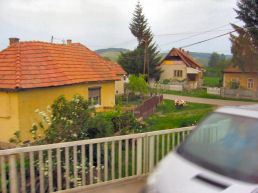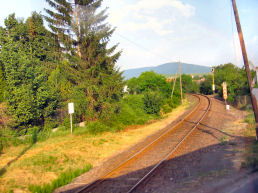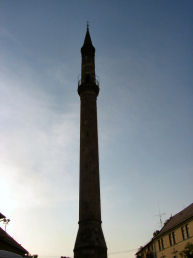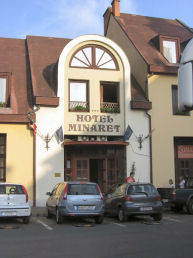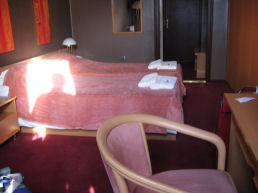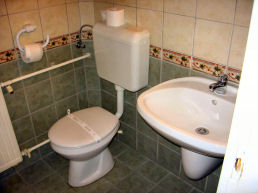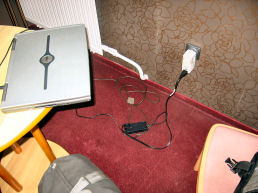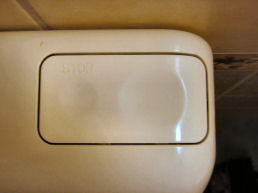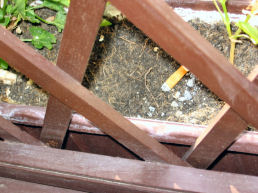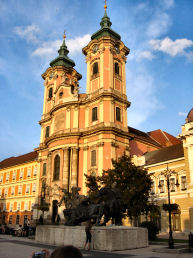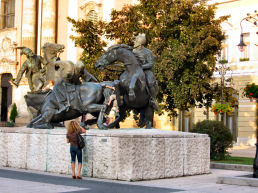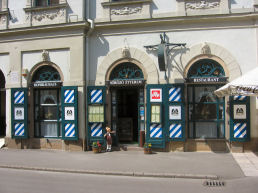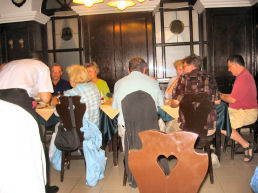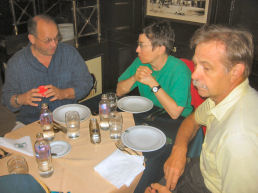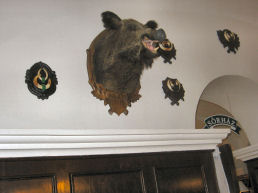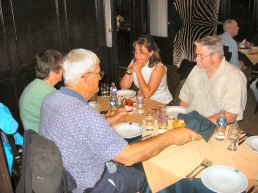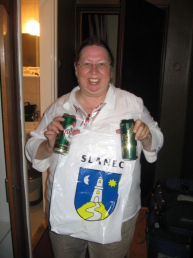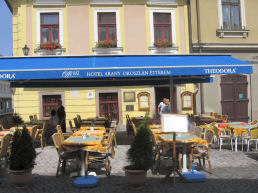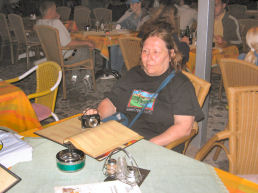I gathered my laundry off of the towel rack. I had to use the hair dryer on two pairs of socks.
I was delighted to find one of my missing pens in the cushions of the chair. Small successes like this can really improve my mood.
Ray had asked me to check up on the Mariners for him. I discovered on ESPN.com that the Red Sox were eleven games ahead. The Mariners were four and a half games behind the Angels. I checked the weather for Kraków and Eger using metcheck.com. It appeared that it would be about 80 today with clouds appearing in the afternoon. It appeared that we would escape getting rained on all day. [Wrong. Not knowing the names of any cities in eastern Slovakia, I could only check the endpoints of the day’s journey.]During the long journey Susana provided us a great deal of information about Poland and even Slovakia. This was a little surprising to me since we were only stopping for lunch there. She said that many of the people in both countries were still intensely religious even after four decades of communism. However, it was difficult to open new churches during that period.
We passed a Catholic church. It was Sunday, and there was a mass in process. As Susana predicted, it was so crowded that some people had to participate in the service from the grounds outside. I wondered what they did in inclement weather or in the winter. Susana told us that each of these countries had a distinctive way of stacking hay. It would never have occurred to me that there was more than one way to stack hay.We learned that England, Ireland, and Sweden had opened their borders to people from the ten new members of the European Union. Hundreds of thousands of Poles had already departed for those countries in search of employment. The low-cost labor had probably helped those countries economically, but some sociological problems (or at least perceived problems) had set in. Some of the countries had been having second thoughts.
According to Susana, the French people voted down the constitution of the European Union because they were worried about the effect of the new members. She also said that many Poles were worried about converting from the złoty to the Euro. They feared that their money would lose value because prices would be higher. The Kusczenskis have come out against it.Poland’s most famous composer, Frédéric Chopin, spent most of his career in France. Nevertheless he has been proudly claimed by the Poles because he integrated Slavic traditional music into his compositions.
The Polish gas station at which we stopped was well stocked. I managed to use up all of my remaining złoty on a Coke Light and onion-flavored potato chips with “extra smak.” This place also offered views of the countryside that were very easy on the eyes.Susana mentioned that she currently lived near Valencia, the home of the Borgias, in Spain. She also said that she would always live in Europe, most likely in Spain or northern Italy.
Susana told us that two to three million Germans were deported from Poland back to Germany after World War II.
The border crossing between Poland and Slovakia was routine. Lauren seemed a little taken aback when I took a photo of the border guard after he left with our passports. If he heard the click, it did not faze him. The bus had two sun roofs. Bojan popped them open when we were stopped, which usually occurred at border crossings.
There were mass demonstrations in Bratislava in 1989. Vladimir Mečiar came to power. Susana said that he was just a criminal. He sold the firms that the Soviets had nationalized to friends and families. Vaclav Klaus, the leader of the Czech Republic was a Thatcherite. He wanted the Slovaks to secede. The Slovakian half of the country was dominated by outdated plants for heavy industry, and Klaus feared that they would hold the Czechs back. In January 1993 the velvet divorce was negotiated between the Czech and Slovak leader. Susana said that not even 40 percent of the people wanted separation. The country had been unified in 1919. The first president was Tomáš Garrigue Masaryk. The Slovaks under Jozef Tiso had cooperated with Nazis after Hitler seized the Sudetenland. Mikuláš Dzurinda cleaned up a good bit of the mess in Slovakia. He restructured the economy and introduced a flat tax - up to 19 percent. Since that time several European countries have moved car production to Bratislava and the vicinity. In 2009 Slovakia plans to replace the koruna with the euro.
Susana told us that the western part of Slovakia had 9 percent unemployment, which is low for a European country. However, in the east the rate is around 30 percent.
Shortly after he assumed the rule of Czechoslovakia, Vaclav Havel closed down the munitions factories in Slovakia. He wanted the country to modernize. This might have been good in theory, but it was hard on the Slovaks.
Robert Fico was elected prime minister in 2006 with promise of reversing reforms. He is the head of SMER, the Social Democratic Party. However, he has been ruling as part of a coalition with questionable staying power.From the crowning of king Steven in 1000 up until 1918 much of Slovakia was ruled by Hungary. There are still a large number of Hungarians in Slovakia. Susana said that Mečiar wanted to deport Hungarians. Susana later told us that there were still approximately 600,000 Hungarians in Slovakia.
There were also a large number of Roma (Gypsies) in both Slovakia and Hungary. They originally came to this area from India, where they had belonged to one of the lowest castes. Many emigrated to Europe through Egypt. Since they first appeared in the fourteenth century, I wondered if they got blamed for the plague. In those days they skillfully worked in iron and produced weaponry. There were now between six and twelve million Gypsies in Europe. Many of the Gypsies are alcoholics, and others have health problems. They account for a disproportionate share of the imprisoned population. They tend to have large families with between six and ten children. Many of the Gypsies do not speak Slovak. They still have arranged marriages, and it is not uncommon for prepubescent children to be married off. After all these centuries they still refuse to assimilate European cultural standards.In Svinia a social worker has tried with Canadian funding to build some houses and get the Gypsy children into boarding school. The jury is still out on how much success the project might achieve. There has been a mass exodus of gypsies to Canada. They have also migrated to England.
Every Gypsy clan has its own king. Susana said that most Gypsies were Catholic, but they had their own saints. [This made no sense to me, but I did not make any noise about it. I know that in some areas people are allowed to venerate people who have not been canonized.] They do not adhere to the concept of private property. Some see nothing wrong with taking property from others. Their unemployment rate could be as high as 70 or even 90 percent. They no longer wore the colorful clothes or drove the wagons associated with them. Susana said that they number several hundred thousand in Slovakia. Trash in their settlements has been a continuing problem.
We saw several storks walking in the fields. Susana posed to the group the riddle of who brings the storks' babies.
Susana told us that the Renaissance style of architecture was popular throughout Slovakia.The farmers here grow red poppies for poppy seeds. The white poppies, which are use for opium, are illegal.It started to rain just before we stopped or lunch, but it was only a sprinkle. We did not get soaked. It was still overcast and cool when we got off of the bus.
Lunch was in the picturesque Slovak town of Levoča in the region known as Spis. It is considered the most beautiful part of Slovakia. Germans from Saxony settled in this area in the thirteenth century, and it was quite prosperous for a long time. However, the railway bypassed the town, and it went downhill. The nicest buildings in the town were left over from the town’s salad days.
Susana told us that the town of Kežmarok was a big rival of Levoča. I had to wonder if they got the railroad. Sue would know; she had a whole folder of the train routes in Slovakia. Sue and Patti went to the bankomat in Levoča and then dragged some unsuspecting cab driver with them on their adventure in search of the Slovak town of Slanec. They hoped to meet up with the mayor and his assistant there and to see Slanec Castle. Their ultimate objective was to meet back up with the tour group at about 10 p.m. at our hotel in Eger in Hungary. To get there they planned to take trains from Slanec to Eger.We ate lunch at a very nice restaurant named U 3 Apostolov. I sat with Tom and Bojan. Nedra joined us a little later. We had Platny Bažant beer. Bojan told us that he thought that it was a Czech beer, but we later discovered that it was probably Slovak. We had an excellent soup, a broth with carrots and beef. The bread dumplings were made from boiled bread. They cut them with thread. We also had beef, gravy with carrots and celery roots, cream, and cranberries. For dessert we had watermelon, pineapple, and strawberries. This was a top-notch lunch.
On the wall of the dining room were three statues, presumably of apostles. Susana had identified one as St. James. I was pretty sure that the other two were John (no beard) and Peter (key).I asked Bojan how many trips he made per year. He said that this year he would be driving eight tours. When we left the restaurant, I left my camera behind. The waitress came running after me and gave it to me. I did not leave any body parts behind.
Levoča’s principal attraction was the incredibly ornate church of St. James. Its altar piece was sixty feet tall. The twelve apostles were on the top part of it. The lower section has statues of St. John, Mary, and St. James. It was produced by Paul of Levoča. My notes also have something about Moses and a bird, but I cannot remember to what they refer.
The church also had a very large number of altars. In fact, I would wager that it must hold the world record for the largest number of altars in such a small space. I had to wonder if there is a relic in every one. If so, they must have had to pay Rome a pretty penny for all of them.
The Lutheran church was constructed in the Greek style and was crowned by a large dome. The cage of shame, which was used for punishment of minor miscreants, was moved from that site across the street. It is now on the grounds of the municipal building.The Rock of St. Mary’s is a famous pilgrimage site. Pope John Paul II named it a basilica in 1990 and visited it twice. When he visited it as pope in 1995, 150,000 people showed up to greet him.
Susana said that the bull rings in Spain are yellow and white in honor of the pope because those are the colors of the papacy. This was a little hard to believe since those have only been the pope’s colors since 1808; before then they were red and yellow. I had to believe that Spain had plenty of bull rings before 1808. In southern Slovakia the terrain changed rapidly. We drove through a thick pine forest. It also became extremely hilly, almost mountainous. We encountered several switchbacks and some really tall trees.Railroad tracks ran alongside the highway for long stretches. In a few cases the bus crossed over the tracks. Ordinarily I paid little attention to such things, but on this leg of the trip I could not help but wonder if Sue and Patti would be on these tracks a little later. I just hoped that they did not find themselves in Belarus or the Ukraine.
At one point I could have sworn that I saw a sign for Slanec on a dirt road a little distance to the east of where we were driving.
We drove past a mining town in which Susana pointed out a Gypsy encampment.After a while the road became too winding for me to concentrate. I had to put my computer aside until it straightened out again.
We saw a family of storks in their nest. They looked a little ridiculous when they stood up.
Susana told us about the concept of Karst, the term for areas riddled with caves. Evidently there were a good number of limestone caves in Slovakia and Hungary. There was also an area of Slovenia with the same name and similar features.
Our toilet break was scheduled for a location just on the other side of the Hungarian border. This turned out to be a real bladder tester. Harlyn was walking up and down the aisle, and, in fact, everyone seemed to be a little squirmy. While we waited for them to process our passports, two cars breezed through. At one point the Hungarian guard opened the Slovak gate. I understood that both of these countries were in the European Union, but did they not know that there was a war on? We finally cleared customs, and Bojan pulled the bus into some kind of a tourist trap that featured a cave or two. We had quite a long hike from the parking lot to the restrooms, which were, thankfully, free. Some of the trees looked quite inviting to me.
The restrooms were identified by little hats. The men’s room had a fedora. The ladies' room had a bonnet. I guessed that they had to hope that their clientele watched old movies.
Our history lesson resumed after we made our bladders gladder. The Turks had held Budapest from 1545 until it was finally liberated in 1686 by the Hapsburgs. In 1867 the emperor granted freedom to Hungary, and half of the empire was ruled by the Hungarians. However, Hungary lost two-thirds of its territory in the treaty of Versailles at the end of World War I. The Hungarian coat of arms includes references to territories that they have not controlled in almost a century. According to Susana, Hungary is in a big mess politically. The socialist prime minister, Ferenc Gyurcsány, admitted that he and his party had done a horrible job of governing and that the only way that they had stayed in power was to lie to the people. The Hungarian government has borrowed an inordinate amount of money. There seemed to be no chance of them being able to convert to the euro any time soon.
Hungary had an uprising in 1956. The Soviets said that they would support the government that overthrew their puppet rulers, but all the time they were planning an massing invasion. After the tanks started rolling in, hundreds of thousands of Hungarians emigrated. In 1989 the Soviets finally left.
The northernmost minaret in Europe was right outside of our Hotel in Eger. The town’s claim to fame was that in 1552 István Dobó held off Turks here. However, others were not so successful, and the Turks soon overran the area.
We reached the Hotel Minaret in Eger at about 6:30. Susana’s advice for getting around Eger was not to worry so much about the streets, but just to walk toward the minaret. Unfortunately, one could not see the minaret from more than a block away because the streets are narrow, and the buildings come right up to the edge of the sidewalk.
I lugged both Sue’s and my luggage up to the room. The accomodations seemed pretty nice, but there was only one window. This would not bother me, but I was afraid that Sue would really suffer if it got any hotter. I tried to prop the window open, but I did not have much success. I put on some long pants and a sweater and went outside.
To my dismay I discovered that all eight of my camera batteries were run down. I certainly was not surprised that the four that I used on the bus were kaput, but I thought that I had recharged the other four in Kraków. I must have gotten mixed up. I was beginning to think that I needed a nanny.Tom was outside already when I went out. The sun had come out, but a chilly wind was blowing. The combination was actually pretty pleasant. Tom told me that he had gotten some money at a bankomat, but it was a lot more difficult than Susana had intimated. He gave me half of his cash. It turned out that he had missed several machines that were not functioning. It was Sunday; maybe they were out of order.
At about seven we assembled to walk to dinner. On the way I noticed that one of the stores had a pair of scissors on display in their window. I naturally figured that it should be an easy matter to rectify that one remaining problem the next day. [Wrong.] The group, less Sue and Patti, walked the few blocks to the restaurant, which was called Sörözö Etterem, or HBH (the name of the beer that they brew and serve) Hoffbräu House. We ate in two long tables in a room that was festooned with heads and other remnants of animals obtained on hunting trips. We identified a zebra skin, a wildebeest’s head, a wild boar’s head, and lots of antelope heads.
The other people near me were Mike Brimmer, who told us how the showerhead in his room had attacked him when he had turned on the water, Tom, Liane, and Andy. Liane seemed to be a little less adventurous than the rest of us with the Hungarian food and drink.
The dinner was outstanding. I skipped the bread with paprika sauce, but I had plenty of goulash, which they pronounce with a y sound after the l: GOOL yahsh. It was different from the previous offerings - more of a soup and more substantial. It was also tastier, IMHO. There were three main courses served family style: spätzle with beef and a sauce; a mixture of sausage, stuffed cabbage, bacon, and pork; and goose livers with mashed potatoes. I liked everything, and I left a clean plate. Desert was some kind of tort and a crepe covered with chocolate. I had two of their beers, for which I owed Mike 1,000 forints. The weirdest thing about the restaurant was the acoustics. Tony and I sat in front of an alcove that seemed to work as an amplifier, or maybe something behind the other people worked like a speaker, or maybe both. We could hear every word said by Ray, Joan, Anne, and Janet. It was a very eerie. I talked with the Reistetters for a few minutes about their home town of Fresno. I told him that I had been there many times to visit Gottschalks. Andy said that they had heard a rumor that Gottschalks might be bought by Wal-Mart. Since Wal-Mart stores were always free-standing, I did not understand why Wal-Mart would want Gottschalks' mall and strip mall stores. However, I supposed that I should look into it. [Gottschalks liquidated in 2009.]Everyone asked about Sue and Patti. I judged that Susana was really worried about them. She kept checking her cell phone. Sue and Patti arrived none the worse for wear at 9:30, just as I finished taking a shower. As expected, Sue found the room’s microclimate intolerable, but she noticed an air conditioning unit that had escaped my attention, so that problem was quickly eliminated.Both of the ladies were hungry, so the four of us agreed to find a restaurant at which they could eat and tell us of their adventure. Just before we left I made the serious mistake of plugging my battery charger into the adapter that Sue had been using for her CPAP machine. I had been using it with my surge protector, which converts the current to 110. I forgot to flip the switch on the charger to the European setting. The lights on the charger came on, and it appeared to be working correctly, but when we returned, the charger was fried.
So now Monday morning would have to be spent looking for eight a new charger or batteries for the camera. I certainly was doing a poor job of taking care of details. I felt like a complete idiot. Could incontinence be far behind?
Sue and Patti had supper at the Hotel Arany Oroszlán. We sat at a table just outside the door of the restaurant. Tom and I drank a beer, listened to their story, and watched them eat supper. Evidently they had hired a cab driver who knew no English at all, drove incredibly fast, and did not really know where he was going. When they got to Slanec, they called their contact, Ivan. He said that he would meet them at 3:00. This meant that their only chance of getting to the castle was to get the cab driver to take them. Unfortunately none of them knew where the castle was. Sue told Ivan that they did not know how to find the castle. He asked her where they were. She said that they were at the church. Ivan said that the road to the castle was right across the street. They looked, and, sure enough, the castle was clearly visible. Patti was able to zoom in on it with her camera and get a pretty good photograph.The cab driver took them part of the way up the mountain, but the roads were evidently not to his taste. No amount of bribing could convince him to take them any farther. At that point he was probably just interested in dumping Lucy and Ethel and getting back to the sanity of his day-to-day existence. He was willing to back up all the way, but Sue helped him find a place to turn his vehicle around.
They then met with Ivan, his wife Maria, and the mayor. Ivan served as translator. It was quickly established that Sue was not the missing Slanec heiress who had returned to lead Slovakia back to its bygone glory. In fact, most of the people in the area were of Hungarian, not Slavic, descent. That closely corresponded with what Susana had told us on the bus, but it had never occurred to me. The Slanec people gave Sue a bag full of gifts. She gave them a picture of the Powder Mill Barn in Enfield and some maple syrup that she had, unbeknownst to me, smuggled through customs.We had a very enjoyable time listening to their stories and joking with the waiter, who spoke English quite well. Tom got to try out his Hungarian, and I must say that I was quite impressed with his efforts. Mind you; I am not easily impressed.
Tom paid for supper. I resolved to create a record of all of our transactions in a spreadsheet. This back and forth was getting out of hand. [I started but never finished this project.]
Even after discovering the fiasco of the batteries, I was so tired that I fell asleep as soon as my head hit the pillow.
